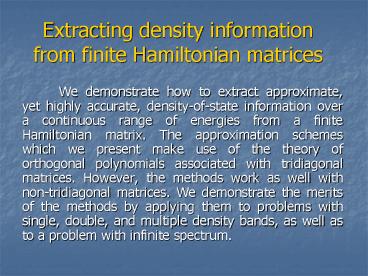Extracting density information from finite Hamiltonian matrices - PowerPoint PPT Presentation
Title:
Extracting density information from finite Hamiltonian matrices
Description:
Extracting density information from finite Hamiltonian matrices We demonstrate how to extract approximate, yet highly accurate, density-of-state information over a ... – PowerPoint PPT presentation
Number of Views:72
Avg rating:3.0/5.0
Title: Extracting density information from finite Hamiltonian matrices
1
Extracting density information from finite
Hamiltonian matrices
- We demonstrate how to extract approximate, yet
highly accurate, density-of-state information
over a continuous range of energies from a finite
Hamiltonian matrix. The approximation schemes
which we present make use of the theory of
orthogonal polynomials associated with
tridiagonal matrices. However, the methods work
as well with non-tridiagonal matrices. We
demonstrate the merits of the methods by applying
them to problems with single, double, and
multiple density bands, as well as to a problem
with infinite spectrum.
2
- With every Hamiltonian (hermitian matrix), there
is an associated positive definite density of
states function (in energy space). - Simple arguments could easily be under-stood when
the Hamiltonian matrix is tridiagonal. - We exploit the intimate connection and interplay
between tridiagonal matrices and the theory of
orthogonal polynomials.
3
(No Transcript)
4
- Solutions of the three-term recursion relation
are orthogonal polynomials. - Regular pn(x) and irregular qn(x) solutions.
- Homogeneous and inhomogeneous initial relations,
respectively.
5
- pn(x) is a polynomial of the first kind of
degree n in x. - qn(x) is a polynomial of the second kind of
degree (n?1) in x. - The set of n zeros of pn(x) are the
eigenvalues of the finite n?n matrix H. - The set of (n?1) zeros of qn(x) are the
eigenvalues of the abbreviated version of this
matrix obtained by deleting the first raw and
first column.
6
- They satisfy the Wronskian-like relation
- The density (weight) function associated with
these polynomials - The density function associated with the
Hamiltonian H
7
y
G00(xiy)
x
?
?
?
?
Discrete spectrum of H
Continuous band spectrum of H
8
Connection
9
For a single limit The density is single-band
with no gaps and with the boundary
For some large enough integer N
10
Note the reality limit of the root and its
relation to the boundary of the density band
11
One-band density example
12
Two-Band Density
giving again a quadratic equation for T(z)
The boundaries of the two bands are obtained from
the reality of T as
13
Two-band density example
Three-band density example
Infinite-band density example
14
Asymptotic limits not known?
- Analytic continuation method
- Dispersion correction method
- Stieltjes Imaging method
15
Non-tridiagonal Hamiltonian matrices?
Solution will be formulated in terms of the
matrix eigenvalues instead of the
coefficients .
16
Analytic Continuation
?
?
?
?
?
?
?
?
?
17
(No Transcript)
18
One-Band Density
Two-Band Density
Infinite-Band Density
19
Dispersion Correction
Gauss quadrature
Numerical weights
20
(No Transcript)
21
n
4
?
?(?)
3
?
2
?
?
1
?
?
0
?1
?2
?3
?4
?0
22
One-Band Density
Two-Band Density
Infinite-Band Density
23
Stieltjes Imaging
24
Stieltjes Imaging
25
One-Band Density
Two-Band Density
Infinite-Band Density
26
????? ??? ??????? ??????? ??? ???? ???????????
????? ????? ???? ???????
Thank you































